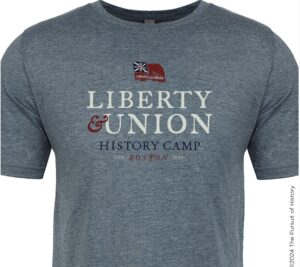While some of the Sunday tours are full, I understand there’s still room in the Suffolk University Law School building for more folks to come on Saturday.
The History Camp Boston website now shows the preliminary schedule for the day. My presentation “Beyond the Thirteen: The American Colonies That Stayed with Britain” is in the opening time slot at 9:30 A.M.
I’m not a morning person, but there’s an advantage to speaking early: I’ll be able to relax, focus on other speakers, and enjoy the rest of the day. As you’ll see, there are lots of sessions about the Revolutionary era!
But my work won’t really be done. In the final time slot, at 4:30 P.M., I’ll be speaking alongside History Camp founder Lee Wright and Scott Nadler from Santa Fe about upcoming Pursuit of History weekends, like the days we organized in April. The first will be in Santa Fe this October.
History Camp Boston’s Saturday session will once again take place at 120 Tremont Street, within sight of the Park Street T station. Doors will open at 8:00 A.M., and there’s a welcome session at 9:00. That gathering will end at 5:30 P.M., but folks can choose to attend Revolution’s Edge at the Old North Church an hour later.
As for the Sunday tours, a fourth was added, making:
- Boston’s Innovation Trail
- Beacon Hill’s 19th Century African American Community
- Witches, Privateers, and Bankers: Five Centuries of North Shore History in Beverly
- A Town Torn Apart: Patriots vs. Loyalists in the American Revolution in Hingham [full]

A question about the T-shirt, John: I associate the phrase "liberty and union" with the lead-up to the Civil War, not to the Revolution. The large painting in Faneuil Hall depicts Webster's Reply to Hayne, a speech in the U.S. Senate in 1830. Daniel Webster's closing words in that speech were "Liberty and union, now and forever, one and inseparable."
ReplyDeleteAre you aware of any use of the "liberty and union" phrase in the 1760s and '70s?
Yes, this phrase appeared on a flag in Taunton in 1774, as described in the Boston newspapers. Locals proudly call it the “Taunton Flag.” At the time it was one among many banners raised on Liberty Poles as towns competed to show their patriotism. I suspect most of those Liberty Pole flags were ordinary red banners with the Union canton. This design stood out because of that slogan sewn onto the field.
ReplyDeleteIn the context of 1774, “Liberty” meant political liberty from unjust parliamentary laws for American communities, not abolition. And “Union” signaled allegiance to the British Empire, despite what critics of the liberty movement might say, and solidarity within the movement. To be sure, the people who raised this flag in Taunton ended up supporting secession two years later.
Delete